Testing turbines to their limits
 A large climatic chamber which can test offshore wind turbine components in extreme temperatures ranging from -60 degrees Celsius to +60 degrees was unveiled in Antwerp on Thursday as part of a new research and development facility.
A large climatic chamber which can test offshore wind turbine components in extreme temperatures ranging from -60 degrees Celsius to +60 degrees was unveiled in Antwerp on Thursday as part of a new research and development facility.
An element of the Offshore Wind Application Lab (OWI-Lab), the climate chamber, is housed inside a structure in Antwerp’s port area. It is capable of testing mechanical, hydraulic and electrical wind turbine components such as gearboxes, generators, yaw systems and transformers weighing up to 150 tonnes.
Typical activities will include design verification, component validation, prototype testing and cold start tests. In addition to the chamber, with dimensions of 10m x 7m x 8m, OWI-Lab will house the tools needed to perform a myriad of dedicated research and development tests.
Set up two years ago to make offshore wind energy more reliable, efficient and cheaper, the OWI-Lab is an initiative of several businesses – 3E, ZF Wind Power Antwerpen, CG Power Systems and GeoSea – together with the federation for the technology industry Agoria, the innovation platform Generaties, Sirris and the Free Univsersity of Brussels. The Flemish government is subsidising the start-up of this project.
The main purpose of the climate chamber test infrastructure, which cost about €2 million, is to identify failures in the early stage of the design process, and to reduce the number of unscheduled failures in the field by testing in extreme conditions, according to a background document provided by Sirris.
“Most offshore wind turbines should be capable of operating at a temperature range from -20°C to +40°C. In some low temperature regions (arctic offshore wind farms for example which are currently planned in the north of Finland and Norway) these turbines even have to withstand -30°C,” the document said.
“For onshore turbines the requirement can be -40°C if we look at remote locations (for example Mongolia). Testing the reliability of these components at extreme temperatures is a must in order to make sure these turbines stay operating in all conditions and to eliminate expensive repair works.”
In addition to testing temperature differences on offshore wind turbine components, the facility will examine other climatic environmental factors such as salt, rain, pressure, humidity and solar radiation.
Reducing the overall costs of offshore wind energy is critical for its competitiveness and for the sector to increasingly help to decarbonise the global energy mix, Dr. Stefan Lammens, Vice President – Chief Sales & Marketing Officer at ZF Wind Power Antwerpen NV, said in an email interview.
For wind turbine gearboxes in particular, Lammens continued, challenges related to operation and maintenance far from shore emphasize the importance of reliability of component parts to reduce operating expenses and enable turbines to produce more energy.
He said tests conducted where environmental and operational conditions can be simulated in a lab are very important to prove reliability of designs.
“OWI’s new climate chamber is a good example of public test infrastructure that will help to reduce the costs for offshore wind projects,” Lammens added.






